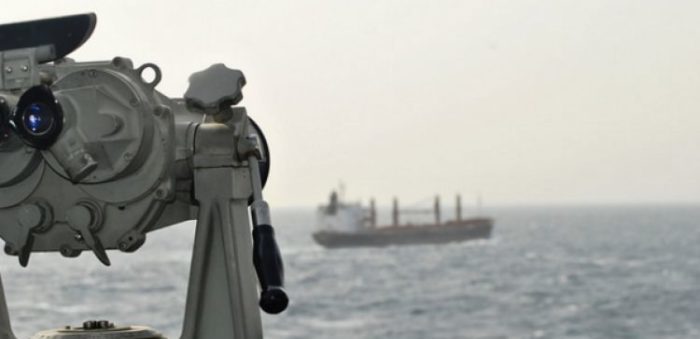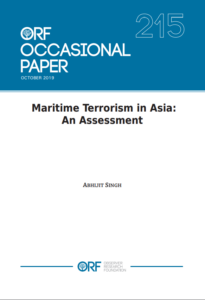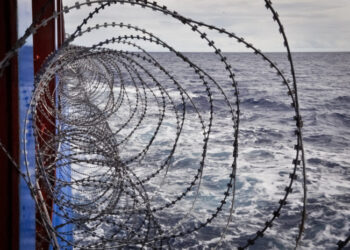The Observer research Foundation (ORF) launched a report focusing on today’s maritime piracy in Asia, analysing where the shipping industry stands, the possibility of piracy in Asia increasing and also measures to improve maritime readiness against piracy incidents.
A former naval officer, Abhijit Singh, Senior Fellow and head of the Maritime Policy Initiative at the ORF, evaluates the possibility of an increase in maritime incidents in Asia, a hypothesis that comes from recent and past attacks in the region. Maritime piracy is a hot topic in the shipping sector, given that violence in the sea is high, particularly in the Sulu and Celebes Sea.
#Piracy-related incidents
- South Asia
A highlight of piracy incidents in the region was in 2014, the attack on PNS Zulfiqar, a Pakistani frigate, in Karachi. The attack was executed by the Tehrik-i-Taliban Pakistan (TTP) and the Al Qaeda, the attack is a case study of how radicalised militant groups attempt to sabotage a nation’s military assets.
- India
India is also prone to piracy incidents; Although terrorists do not target any Indian shipping or maritime installations, the possibility of an Al Qaeda-inspired attack is far from hypothetical. High-tech equipment is enabling attackers to execute their plans with great precision.
- Southeast Asia
The report notes that Southeast Asia is one of the most ‘attacked’ regions; From 2014 to 2018 there were nearly 200 actual and attempted attacks on ships in the littorals.
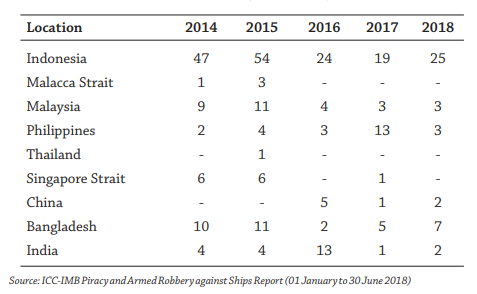
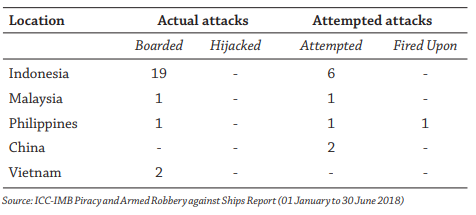
The report indicates that it is challenging for regions to deal with the Abu Sayyaf Islamic military group, as its primary area for activity is the Philippine seas, where Manila is less than eager to allow access to foreign maritime forces, resulting in a slowdown of security operations.
Manila has been particularly cautious, fearing that bigger and more competent maritime forces would eclipse the Philippines’ navy and coast guard in its own backwaters.
#Dealing with piracy
Securing ports still remains the biggest barrier in coping with piracy related incidents;
Yet, regional governments have taken better measures to protect ships and onshore facilities.In many ports, authorities have increased guards, gates, and security cameras, even introducing identification card programs to screen those with access to critical port infrastructure.
The installation of radiation detectors has been particularly helpful in screening critical cargo and identifying suspicious shipments.
Despite the efforts, Asian ports are not able to track and monitor large containers comprehensively. Consequently, it is easier for pirates to use containers to smuggle in arms, explosive materials or the terrorists themselves.
#The future of piracy
The report notes that:
- The most likely venue of a future terrorist strike might be inside a port facility; Because the Asian and African ports do not have mine neutralisation systems or integrated coastal defence, seems to suggest an increased possibility of an underwater attack;
- The most vulnerable targets remain the tankers as the recent developments show, with an Iranian tanker being hit by missiles off Saudi Arabia or the attacks in May and June in Strait of Hormuz against tankers;
- Another kind of piracy attack could be cruise ships; Big cruise ships are a lucrative target since they are lightly defended and relatively easily accessible.
Recently, Nigeria launched the Suppression of Piracy and other Maritime Offences Act 2019, issued in June 2019 by President Muhammadu Buhari, making Nigeria the first country in West and Central Africa to have a standalone antipiracy law. The Nigerian Maritime Administration and Safety Agency (NIMASA) facilitated the drafting of the Suppression of Piracy and other Maritime Offences Bill in 2012, in collaboration with the International Maritime Organisation.
Concluding, to tackle piracy, regional states need structured and efficient ways of investigating threats, identifying vulnerabilities, and getting stakeholders involved in anti-terrorism processes, and a strong legislation to boost their security measures.
To explore more click on the PDF herebelow
































